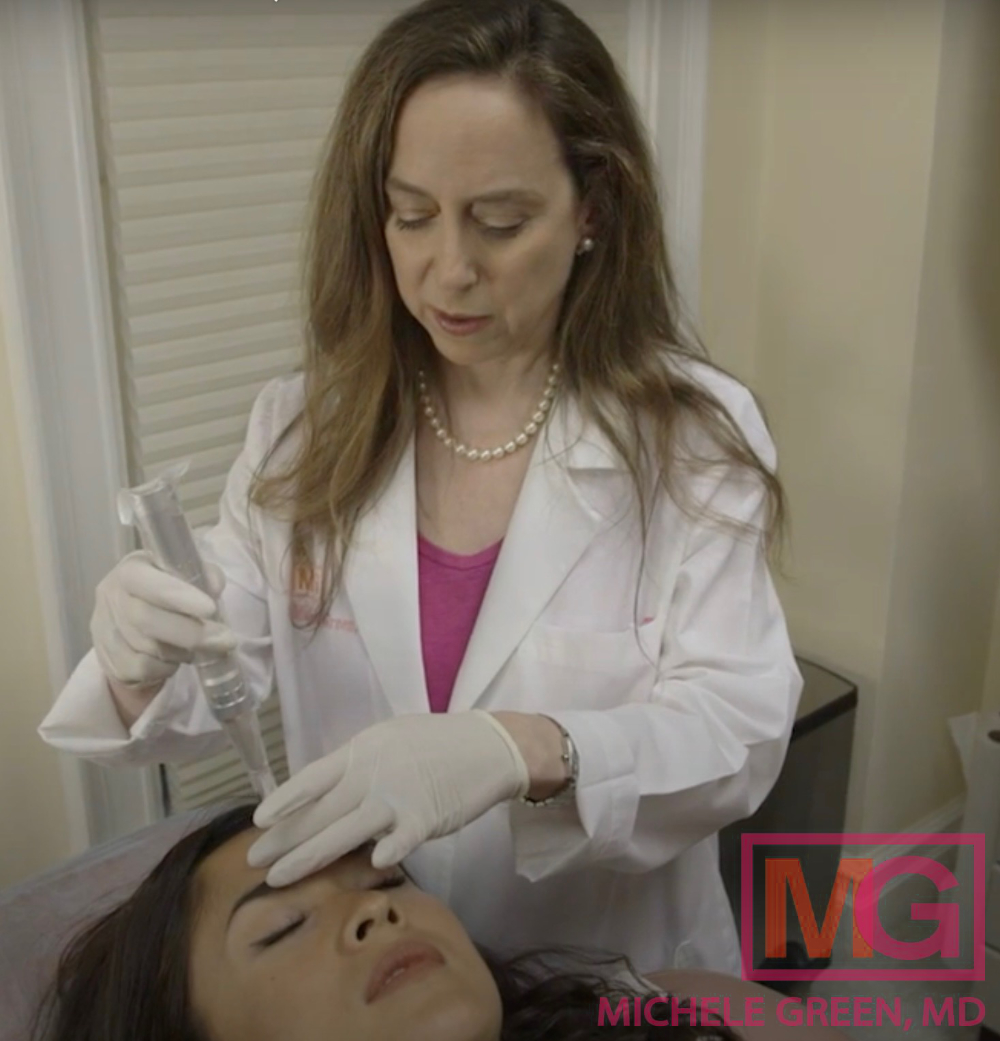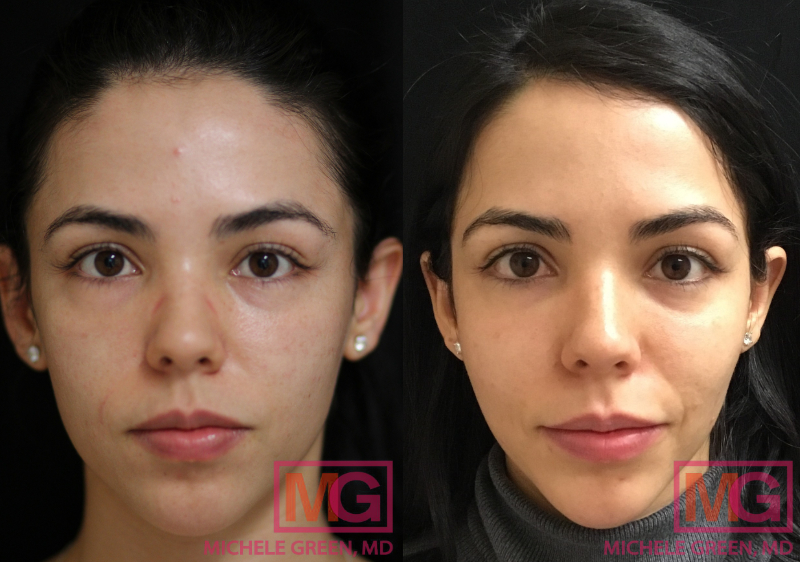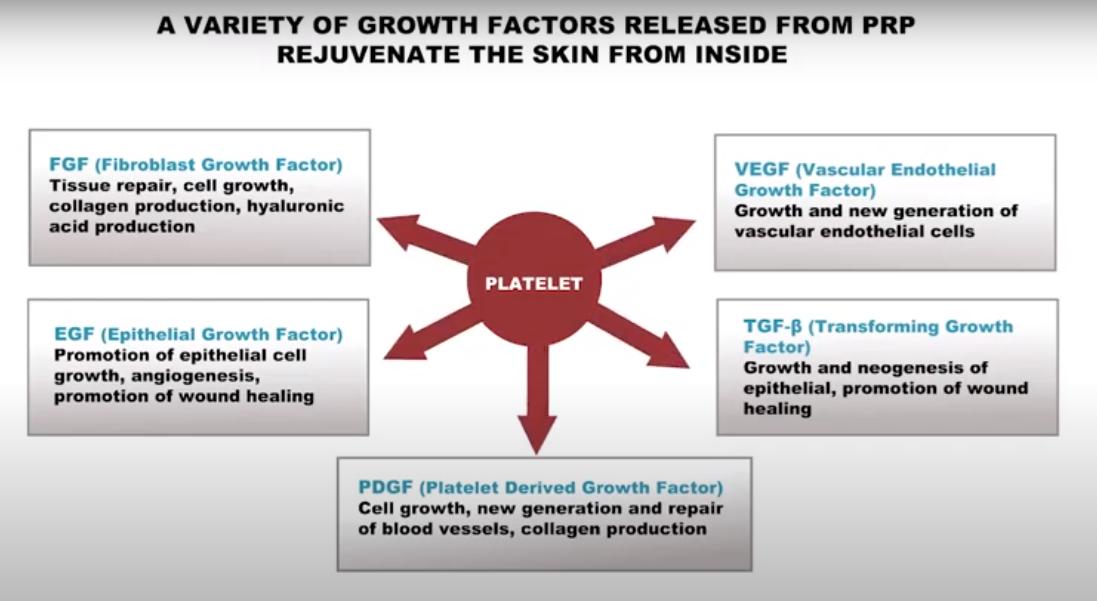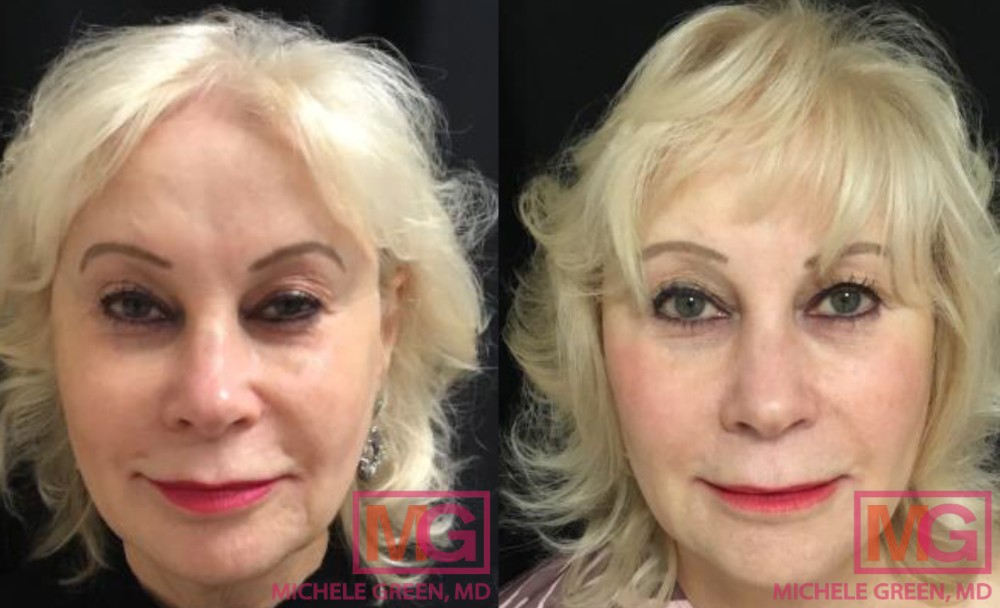PRP for Dark Circles
As we age, the production of the structural proteins collagen and elastin begins to decline, resulting in reduced skin elasticity, thinner skin, uneven skin tone and texture, and the appearance of fine lines and wrinkles. The under-eye area is particularly susceptible to these signs of aging, as the skin under the eyes is especially thin. The appearance of dark circles under the eyes can be particularly distressing for patients. Under-eye circles may be caused by the formation of hollows that create shadows, discoloration due to the appearance of blood vessels under the skin, or pigmentation resulting from sun exposure and increased melanin production. The best first step in addressing under-eye concerns is to schedule an appointment with an expert board-certified dermatologist, such as Dr. Michele Green, who can determine the root cause of dark circles and propose a treatment method for rejuvenating the under-eye area. One such treatment option is platelet-rich plasma (PRP) injections, which boost collagen production, increase blood flow, and thicken the skin for an overall more youthful and well-rested appearance.
Platelet-rich plasma is a non-surgical treatment consisting of a serum derived from a sample of the patient’s blood. After collecting the blood, it is spun in the centrifuge to separate the plasma from the red blood cells. The plasma is packed with epidermal growth factors that enhance the production of new collagen within the skin. By taking advantage of the skin-rejuvenating benefits of PRP therapy, either through a PRP microneedling facial or PRP injections, patients can enjoy a smoother, brighter, and firmer complexion without the need for invasive surgery or extensive downtime. Dr. Green regularly treats her patients with cosmetic procedures that incorporate the use of platelet-rich plasma to provide them with pan-facial rejuvenation.
Dr. Michele Green, a board-certified cosmetic dermatologist in New York City, has over 25 years of experience providing her patients from around the world with the best non-invasive cosmetic treatment options, including Microneedling with PRP, PRP injections, cosmetic injectables such as Botox and dermal fillers, and laser skin resurfacing treatments. In her private, boutique dermatology office, located on the Upper East Side of Manhattan, Dr. Green works closely with each patient to create a customized skincare and treatment plan specifically tailored to their unique skin needs, helping them achieve their personal aesthetic goals. Her dedication to her patients and her practice is well reflected by the fact that she is consistently voted as one of New York’s top dermatologists by Castle Connolly, Super Doctors, and New York Magazine.
What is platelet-rich plasma (PRP) treatment?
Platelet-rich plasma (PRP) therapy is a modern treatment that utilizes the growth factor proteins found in a patient’s blood to promote healing, strengthen and encourage the growth of new cells, and assist with blood clotting. PRP treatment is commonly used for various medical purposes and skin conditions, including aiding in wound healing and musculoskeletal injury recovery, skin rejuvenation, and preventing hair loss. The procedure begins with a blood draw, which is then placed in a centrifuge to separate the red and white blood cells from the platelet-rich plasma within the sample. When the PRP solution is injected into the treatment area or applied to the face following a microneedling treatment, it aids in the healing process, improves blood flow and circulation, thickens the skin, and stimulates the production of elastin and collagen, resulting in smoother, clearer, and more youthful-looking skin. PRP injections are particularly advantageous in sensitive areas like the under-eye area, because the treatment uses the patient’s blood, meaning there is a low risk of allergic reaction and minimal downtime.

Does PRP work on dark circles?
Dark circles are areas of shadows or pigmentation found under the eyes in the tear trough area. Under-eye circles can form for several reasons, so it is always best to consult with an expert dermatologist, such as Dr. Michele Green, to determine the underlying cause before she recommends the best treatment option. Some patients may experience dark circles under the eyes due to under-eye hollows, which are caused by volume loss and sagging skin, creating shadows under the eyes. In that case, Dr. Green may recommend under-eye filler, which can replace lost volume and reduce the appearance of shadows. Some dark circles are caused by pigmentation on the skin itself. The skin under the eyes is very thin and delicate, making it particularly susceptible to signs of aging, stress, and fatigue. Thinning under-eye skin means that blood vessels under the skin may be more visible, contributing to a dark, shadowy appearance. In such cases, Dr. Green often turns to PRP injections, which help thicken the skin under the eyes, improve circulation, and boost the natural healing process to reduce the appearance of dark circles under the eyes. PRP injections can also reduce the appearance of crow’s feet at the corners of the eyes by tightening the skin.
How does PRP therapy work for under-eye area rejuvenation?
PRP therapy is highly effective at improving skin tone and texture in the under-eye area. The platelet-rich plasma in the blood is particularly rich in growth factors, which are very important for the body’s natural healing process. Growth factors in PRP can boost elastin and collagen production, improving skin elasticity, thicken the skin to create more distance between the skin’s surface and underlying blood vessels, and reduce fluid retention, which helps to decrease puffiness. All these factors working together provide patients with brighter, smoother, and more evenly textured skin, resulting in an overall more rejuvenated appearance.
What is the procedure for PRP injections into the tear trough area?
PRP treatment works in three steps for skin rejuvenation:
Step 1: Blood Draw
Your healthcare practitioner will begin by drawing approximately 1-2 tubes of your blood and placing the sample in a centrifuge. All of the materials necessary for the preparation of PRP have been FDA-approved for cosmetic and medical use. PRP itself is not considered a drug since it is derived from the patient’s blood. Dr. Green recommends that patients avoid blood thinners, alcohol, and smoking for at least a week prior to the procedure.
Step 2: Separate the platelet-rich plasma
The centrifuge separates the platelet-rich plasma from the red blood cells. The isolated plasma is rich in growth factors.
Step 3: Injection or application
Once the plasma has been separated, the solution can be injected into the treatment area or applied to the face. Patients may experience minor side effects from the injections, such as some bruising and redness at the injection site. However, downtime is not necessary, and these side effects should resolve within one to two days. Before the injections begin, Dr. Green will apply a topical numbing cream to minimize patient discomfort during the procedure.
How many sessions of PRP for dark circles?
To achieve optimal treatment results, Dr. Green recommends that patients undergo three to four treatment sessions, spaced four to six weeks apart. While many patients will see the effects of the treatment after a single session, the results will be more apparent with multiple treatment sessions. After your first treatment session, Dr. Green’s office will help you schedule your follow-up appointments.

What are the side effects of PRP under the eyes?
As platelet-rich plasma injections utilize the patient’s blood for treatment, there is a very low risk of allergic reaction or serious side effects. Patients may experience bruising, swelling, or redness at the injection site, but these side effects typically subside within one week of the treatment. As with any injectable treatment, there is a risk of infection at the injection site. However, that risk decreases significantly when you follow the aftercare instructions and seek treatment from an expert injector, such as Dr. Michele Green. If you take medication that is also a blood thinner, be sure to disclose that information to Dr. Green before your treatment.
How much downtime is needed for PRP under-eye treatment?
PRP under-eye injections do not require any downtime following the treatment, and patients can immediately return to regular activities. Dr. Green recommends that patients avoid strenuous physical activity for three to four days following the injections to avoid swelling and bruising at the injection site. Patients experiencing swelling or irritation at the injection site can gently apply a cool compress to the under-eye area to relieve discomfort.
How long does PRP under-eye last?
PRP injections are a long-lasting treatment option for patients experiencing dark circles under their eyes. While many patients will see immediate results following the injection, the effects of the treatment will continue to improve over time as new collagen is produced in the treatment area. The results of PRP treatment can last for up to two years; however, Dr. Green recommends that patients schedule annual PRP injection appointments to maintain the treatment’s effectiveness and optimal benefits.
How to remove dark circles under the eyes permanently
Many treatments can effectively eliminate the appearance of under-eye bags without the need for surgery, including PRP injections, dermal fillers, microneedling, chemical peels, laser resurfacing, and various topical skin care products. While these treatments are long-lasting and can be repeated for continued volume restoration under the eyes, one treatment is not a permanent solution. Dr. Green recommends that patients schedule annual appointments to maintain the results of the treatment.
How much does PRP for dark circles cost?
Treatment cost can vary based on your geographic location, the type of institution at which you receive treatment, and the size of the treatment area. While seeking treatment from a board-certified dermatologist, such as Dr. Green, may be more expensive than receiving treatment from a less experienced practitioner, the risk of developing serious side effects significantly decreases when you receive treatment from an expert. The number of treatments can also affect the total price of each round of treatments, and the number of treatment sessions required can depend on the size and scope of the treatment area, as well as the condition being treated. After your initial consultation with Dr. Green, her office will be able to provide you with a clearer estimate of the cost of the treatment based on these factors.

What are the benefits of PRP?
Platelet-rich plasma injections provide many benefits, including:
- Brightening dark circles in the under-eye area quickly and effectively
- Thickening the skin to reduce the appearance of blood vessels and lighten the skin
- Boosting elastin and collagen production for firmer, tighter skin
- Reducing the appearance of fine lines and wrinkles
- Evening out skin tone
- Improving blood flow and circulation, which allows more oxygen and nutrients to reach the treated area
In addition to these treatment benefits, PRP injections are a cost-effective treatment option that offers minimal downtime and long-lasting results.
Can PRP therapy be also used for hair loss?
PRP for hair loss works through the injection of the high platelet count plasma found in the patient’s blood into the area of the scalp where hair loss is beginning to show. This platelet-rich plasma works to activate proteins in the body called “growth factors,” which serve various beneficial purposes. When it comes to the prevention of hair loss, growth factors can work to improve circulation in the treatment area, which can help to thicken the hair follicle. As a result, the new hair growth at the injection site is thicker and healthier looking. Furthermore, these growth factors can help heal and reactivate hair follicles, thereby increasing hair count in the affected area. The proteins also stimulate the papilla cells, which help promote new hair growth. Altogether, this means that PRP treatment works to strengthen the hair follicle for thicker hair and activate previously inactive hair follicles for new growth, which serves to counteract hair loss.
Which is better for under-eye rejuvenation: PRP therapy or dermal fillers?
Dermal fillers are a safe and effective treatment option for eliminating dark circles caused by volume loss and under-eye hollows. If under-eye bags are caused by volume loss or tear-trough hollows, Dr. Green often recommends dermal fillers, such as Restylane, Juvederm, or Belotero. Using a small needle or cannula, Dr. Green will precisely place the dermal filler under the skin. Most patients do not experience any discomfort associated with the treatment, as dermal fillers contain a numbing solution called lidocaine, which helps to reduce the risk of pain during the injections. When injected into the under-eye area, the hyaluronic acid filler immediately replaces lost volume, fills in hollows, erases fine lines and wrinkles, and hydrates the skin. While the treatment is very long-lasting, the body eventually breaks down the hyaluronic acid gel, causing its effects to wear off over time. However, the procedure can be repeated approximately once a year to maintain the results.

Can I leave PRP on my face overnight?
In some cases, platelet-rich plasma can be used for a PRP facial or applied to the skin following a microneedling appointment. When PRP is applied to the skin’s surface, it needs time to absorb into the treated area. Typically, Dr. Green recommends that patients leave the PRP solution on the skin for eight hours. Patients can schedule their appointment for later in the day and keep the solution on overnight before washing it off with an approved, gentle cleanser.
Is PRF or PRP better for the under-eyes?
Platelet-rich fibrin, or PRF, is another injectable solution that uses the body’s blood to revitalize the under-eye area and reduce the appearance of dark circles. PRP and PRF differ in how the blood is processed before the injections. PRP is acquired by spinning the blood sample very fast in the centrifuge, which isolates the platelet-rich plasma. For PRF, the centrifuge is set to spin more slowly, which means that stem cells, fibrin, and some white blood cells remain in the solution. As a result, no anticoagulants are needed for PRF, allowing the growth factors to be released more slowly and effectively. Neither option is inherently better for the under-eye area; rather, Dr. Green will generate the treatment plan that is most effective for you.
Does PRP help with under-eye darkness?
PRP injections are a safe and effective treatment option for dark circles in the under-eye area. Platelet-rich plasma is packed with growth factors, which help to boost collagen production for thicker, smoother, brighter skin. The injections are particularly effective in cases where the dark circles are caused by pigmentation or discoloration. For patients experiencing under-eye hollows and dark shadows due to volume loss, under-eye fillers may be a more effective solution. To find out which treatment option will be best for you, schedule a consultation appointment with Dr. Michele Green.
Is PRP under-eye worth it?
Patients who receive PRP injections for dark circles under their eyes find that the treatment is highly effective at erasing signs of pigmentation. Multiple treatment sessions are generally recommended for achieving optimal results, but many patients find that they can see improvement after a single session. PRP injections also provide long-lasting results, with patients seeing the effects of the treatment for a year or more. Dr. Green recommends that patients schedule annual appointments to maintain their results.
How to get started with PRP under-eye treatment today
Over time, signs of aging, stress, and fatigue can become visible on the face, particularly in the delicate area around the eyes. Dark circles can form under the eyes due to volume loss, high stress, sun exposure, dehydration, lack of sleep, or genetics, leading many patients to wonder if there is a possible solution. Platelet-rich plasma injections (PRP) are a highly effective treatment option. The injections are derived from the patient’s platelet-rich plasma, making them very low-risk for side effects and requiring minimal downtime following the procedure. PRP injections can provide patients with brighter, clearer, thicker, and more evenly toned skin, helping to erase dark circles for a more youthful and well-rested appearance. To find out if PRP under-eye treatment is right for you, schedule an appointment with expert board-certified dermatologist Dr. Michele Green.
Dr. Michele Green is an internationally renowned board-certified dermatologist with over two and a half decades of experience providing her patients with the best non-invasive treatment options. Dr. Green takes a holistic approach, embracing a less-is-more philosophy, and creates customized skincare routines and treatment plans that cater to the unique concerns and aesthetic goals of her patients. She is consistently identified as one of New York’s best dermatologists by Castle Connolly, New York Magazine, and Super Doctors for her dedication to her patients and expertise. Please call us at 212-535-3088 or email our New York City-based office today to schedule a consultation with Dr. Michele Green and find out if PRP injections are right for you.
 212-535-3088
212-535-3088